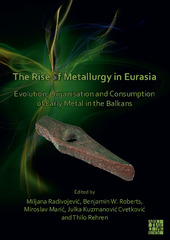Приказ основних података о документу
Ground and abrasive stone tools from Belovode.
| dc.creator | Dimić, Vidan | |
| dc.creator | Antonović, Dragana | |
| dc.date.accessioned | 2023-11-23T10:26:36Z | |
| dc.date.available | 2023-11-23T10:26:36Z | |
| dc.date.issued | 2021 | |
| dc.identifier.isbn | 978-1-80327-042-5 | |
| dc.identifier.isbn | 978-1-80327-043-2 | |
| dc.identifier.uri | http://rai.ai.ac.rs/handle/123456789/816 | |
| dc.description.abstract | The analysis of ground and abrasive stone tools from Belovode encompassed an assemblage of 68 artefacts found in Trench 18, excavated in 2012 and 2013 and relatively dated to between the Vinča–Tordoš II (VinčaB1) and the Vinča–Pločnik I (Vinča C2) phases of the Vinča culture. The tools were categorised according to two criteria: the method of tool production and their functionaltypological characteristics. ‘Ground’ and ‘Abrasive’ stone tools were further grouped into types and subtypes, according to their morphology and function. The typological-functional analysis was conducted according to the morphological characteristics of the tools and traces of observable use. It was based on general observations and the correlation of the metric characteristics of certain tools and their position within a previously defined framework (Antonović 1992, 2003, 2014c), and was applied to all tools possessing the minimum preserved evidence necessary for analysis. The identification and definition of use-wear traces was conducted through comparison of data from the same category of material at other sites (Semenov 1976; Olausson 1983a, 1990; Adams 1988; 1989; 2002; Adams et al. 2009; Pritchard-Parker and Torres 1998; Dubreuil 2001; Plisson and Lompre 2008; Pawlik 2007; Antonović 1992: 20–23; Dimić 2013a, 2015). Tool traces caused by the production process were also recorded to provide indications of the techniques used by Belovode craftspeople in the processing of different types of rock. All analyses were carried out at the Institute of Archaeology in Belgrade using magnifying glasses of up to 16× magnification and the Celestron® USB microscope-camera (with up to 100× magnification), with a connecting camera. | sr |
| dc.language.iso | en | sr |
| dc.publisher | Oxford: Archaeopress | sr |
| dc.relation | The Rise of Metallurgy in Eurasia (UK Arts and Humanities Research Council (AHRC). | sr |
| dc.rights | openAccess | sr |
| dc.rights.uri | https://creativecommons.org/licenses/by-nc-nd/4.0/ | |
| dc.source | The Rise of Metallurgy in Eurasia: evolution, organisation and consumption of early metal in the Balkans. | sr |
| dc.subject | Neolithic | sr |
| dc.subject | Polished stone tools | sr |
| dc.subject | Abrasive stone tools | sr |
| dc.subject | Belovode | sr |
| dc.subject | manufacture and use | sr |
| dc.subject | analyses | sr |
| dc.subject | archaeotechnology | sr |
| dc.title | Ground and abrasive stone tools from Belovode. | sr |
| dc.type | bookPart | sr |
| dc.rights.license | BY-NC-ND | sr |
| dc.rights.holder | sr | |
| dc.citation.epage | 214 | |
| dc.citation.spage | 205 | |
| dc.description.other | In: Radivojević, M., Benjamin W. Roberts, B. W., Marić, M., Kuzmanović Cvetković, J., and Rehren, T. (eds.), The rise of metallurgy in Eurasia: Evolution, organisation and consumption of early metal in the Balkans, pp: 205–214. Oxford: Archaeopress. | sr |
| dc.identifier.doi | 10.32028/9781803270425 | |
| dc.identifier.fulltext | http://rai.ai.ac.rs/bitstream/id/1869/bitstream_1869.pdf | |
| dc.type.version | publishedVersion | sr |


